Greek city Athens's charm lies in the fact that it is a living museum. Kalpana Sunder writes about the city, which offers the best of classical and modern worlds through its museum-like metros, centuries-old amphitheatres and chic nightclubs
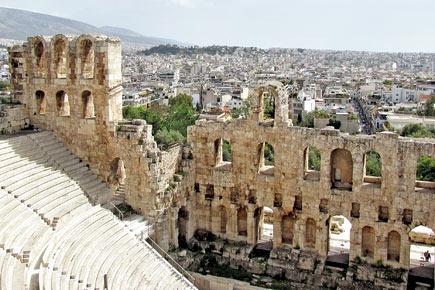
Theatre of Herodes Atticus
Athens, Greece
Best time to visit: September-June
You need: 3-4 days
I wander through narrow, winding cobblestone lanes, flanked by pastel-coloured houses, their red roofs and balconies festooned with pink bougainvilleas. There are small tavernas hosting dance shows, souvenir shops selling Greek jewellery in traditional designs and worry beads called kombouli, olive oil soaps, evil eye amulets and marble busts of gods and goddesses. Old men dressed in white coats sell hot, flaky, sesame- encrusted bagels, while small groups gather around a backgammon board and tourists sip cold frappes on outdoor tables. At a traditional dance show, where a Greek dinner of salads, feta in phyllo pastry and baked moussaka is served, women dancers in traditional long skirts with aprons and sashes worn with ruffled blouses, twirl and prance, while the men in embroidered boleros and baggy pants sway gracefully to the sounds of ‘Opa’.
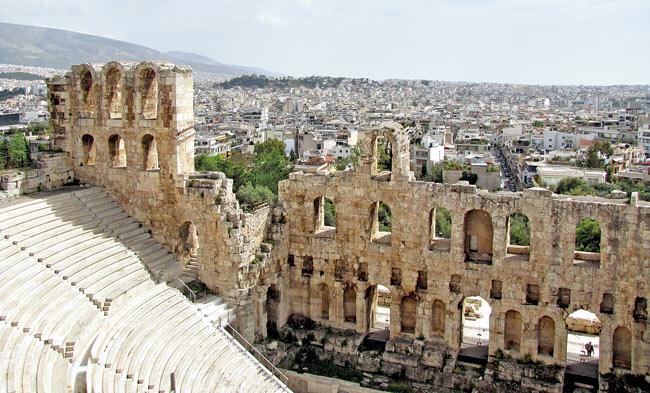
Theatre of Herodes Atticus
I am in vibrant Plaka — the heart of Athens — also known as the ‘Neighbourhood of the Gods’ because of its location, which literally falls in the shadow of the Acropolis.
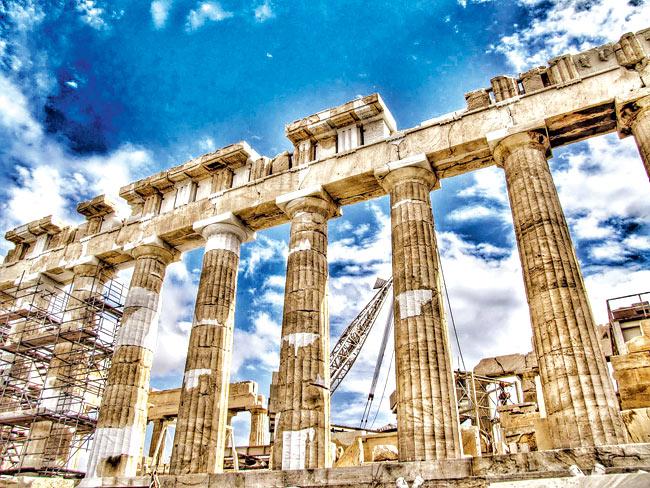
The iconic Pantheon, which stands sentinel over the city
Part of the city’s charm lies in the fact that it’s a living museum. I climb up the marble steps, lined by cypress trees, which lead the way to the iconic Parthenon. This stands sentinel over the city, having endured centuries of wear, bombing and attacks and even pollution. From the heights of the Acropolis, I look down at the urban sprawl of Athens as well as the Temple of Zeus with its Corinthian columns and the conical Lycavittos Hill in the distance. I walk to the Erecthion with figures of draped women as pillars, who seem to casually support the weight of the roof on their heads. The temple was built at the sacred spot where Poseidon struck his trident and Athena produced the olive tree.
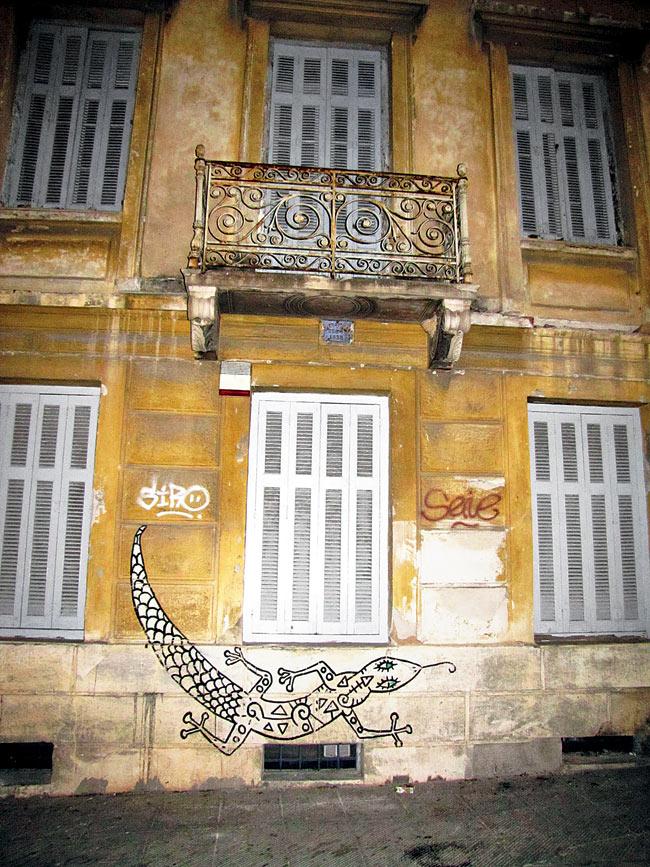
Graffiti lined streets in the artsy student district, New Berlin
The hill is littered with cruise ship guides bearing placards, engineers supervising the restoration of the columns and couples kissing against the perfect backdrop. The Parthenon, built on the highest point of the Acropolis, was once a temple, garrison, mosque and church during its long existence. It also housed a mammoth gold-plated statue of Athena with a statuette of Nike, the goddess of Victory, in her hand. The gold was removed by troops to pay for wars, it was later gilded with bronze, and finally removed by the Roman in 5th Century AD.
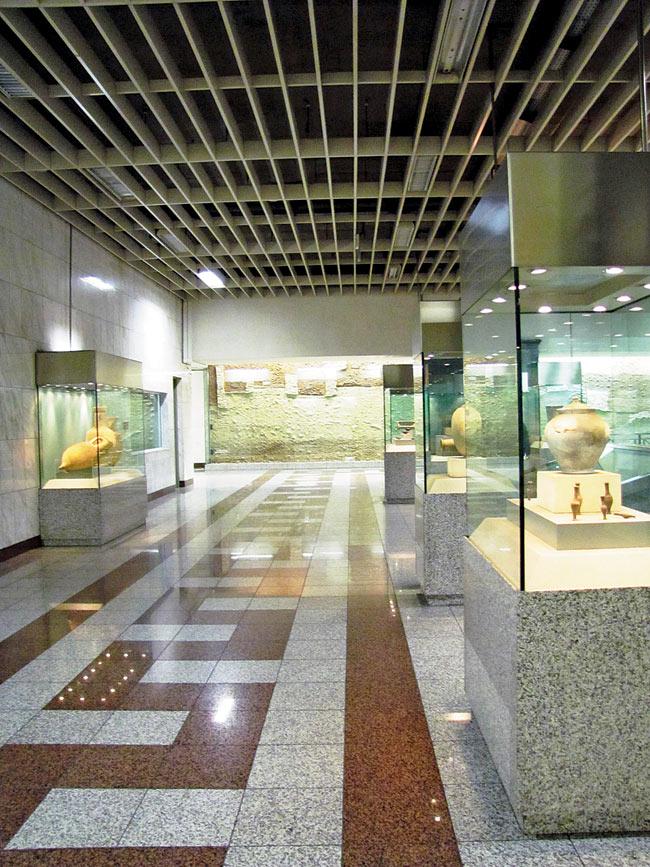
Metro stations that act as mini museums
I walk through the stunning stone structure of the Odeon of Herodes Atticus, a 2,000-year-old amphitheatre with Roman arches, nestled in the hill. The acoustics are so good that if you dare to recite Homer, your voice will travel to the topmost tiers! From the month of May to October, this structure, which can accommodate 5000 people, is brought to life with plays, dance and music during the Athens Festival, which has attracted the likes of top performers such as Yanni and Nana Mouskouri.
A taste of the ancient and classical
If you have time for only one museum, let it be the sleek New Acropolis Museum, built over an extensive archaeological site, the floor, outside and inside, is often transparent using glass and thus the visitor can see the excavations below. Built at a whopping cost of 130 million euros and designed by a Swiss architect using straight lines, glass and concrete, it follows a route that steadily climbs up, simulating the climb to the Parthenon, with statues, busts and sculptures as well as great views of the Parthenon. My favourites are the sixth century kores — statues of maidens with flowing robes and elaborate headdresses, recovered from a pit on the Acropolis, who were votives to Goddess Athena.
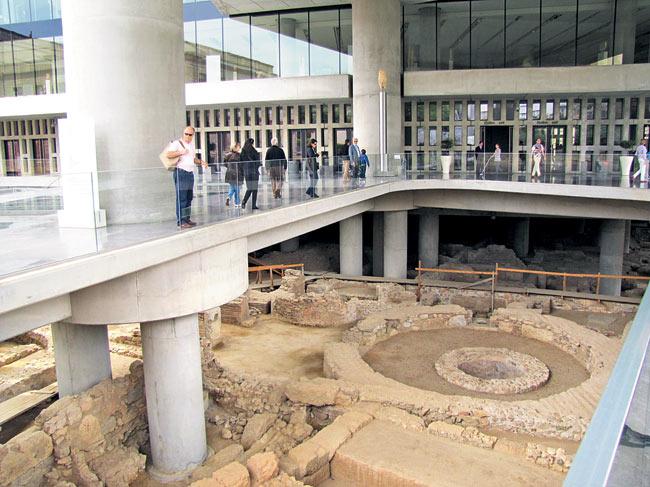
The New Acropolis Museum built over the old city
The top floor of the museum mirrors the dimensions and the structure of the Pantheon. It has the frieze or the marble sculpture that ran around the Parthenon once — many are plaster copies and the missing pieces were removed by Lord Elgin (who obtained a controversial permit to remove pieces from the Parthenon while serving as the British ambassador from 1799 to 1803), and are in the British Museum now. Greece is still urging Britain to return them.
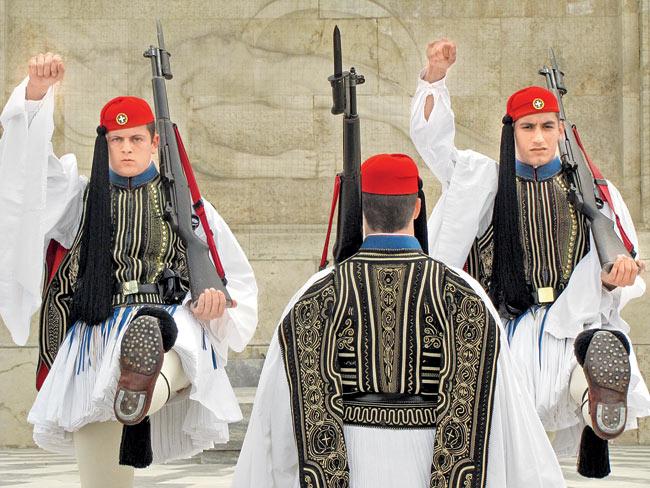
The Change of Guards at Syntagma Square. Pics/Kalpana Sunder
Making way for the new
Along with my guide Yulieth Saad, I watch the Change of the Guards at the Tomb of the Unknown Soldier in Syntagma Square, a bustling plaza lined with orange trees. The show stoppers here are the handsome evzones, elite members of the Presidential Guards, in their trademark uniform of red hat, skirt with 400 pleats and red clogs with pompoms. It is popularly believed that the tallest and most handsome soldiers from the Greek military service are selected for the job.
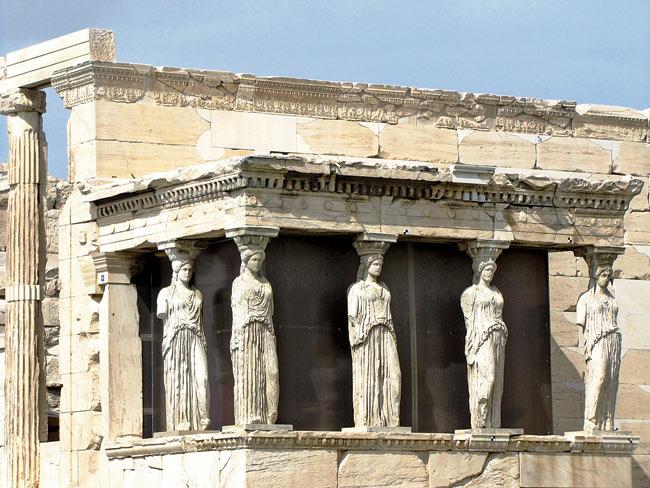
The Erecthion with figures of draped women as pillars
History lurks at every corner of this ancient city. I have my ‘Chariots of Fire’ moment with a selfie taken at the gates of the Panathenaic Stadium, a multi-purpose stadium that is completely made of marble and which hosted the first modern Olympic Games in 1896. I walk along the Unification of Archaeological sites, which is a two and a half mile long walkway connecting ancient sites. I chase the ghosts of Socrates and Plato in the ruins of the deserted Agora or marketplace, which is the real heart of ancient Greece. Here, at the giant field with swaying olive trees and rambling ruins, I sit on a rock with red poppies which grow through the cracks.
But the real adventure begins when I look beyond the clichés. Just a short walk from Ommonia Square I discover an artsy student district called New Berlin filled with colourful graffiti. In the Psyrri district, north of the Acropolis, which was once a down-and-out workshop area, I find young Athenians dancing the night away in chic bars with DJs.
Later, while riding the metro train with Yulieth, I unravel one of the city’s well-kept secrets. When the city began excavations to build the Metro line in the 90s, many statues, aqueducts, cisterns, graves, cemeteries and artefacts were dug up and many of the finds were showcased in the stations themselves. Along with a few pieces of contemporary art, a few of these metro stations now resemble small museums. At Syntagma station, below the Parliament Square, I see huge urns, ancient roads and mosaics from different periods of Greek history, ranging from pre-historic and Byzantine to classical.
While its power to draw tourists will always lie in its classic ancient sights, take time to discover Athens’ rich culture and gastronomic delights. On my last day in the city, I realise that the city shines at night too. Athens, by night, is magical, thanks to the brilliant illumination of ancient monuments by French designer Pierre Bideau. As the evening rolls in, I sit in my balcony looking at the Acropolis, illuminated by spotlights. Head in the future, feet entrenched firmly in the past — that’s Athens for you.
 Subscribe today by clicking the link and stay updated with the latest news!" Click here!
Subscribe today by clicking the link and stay updated with the latest news!" Click here!









